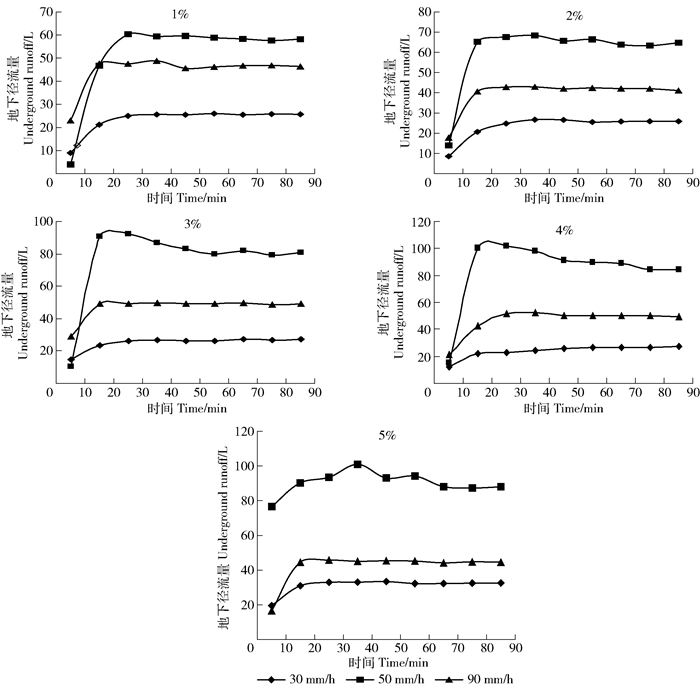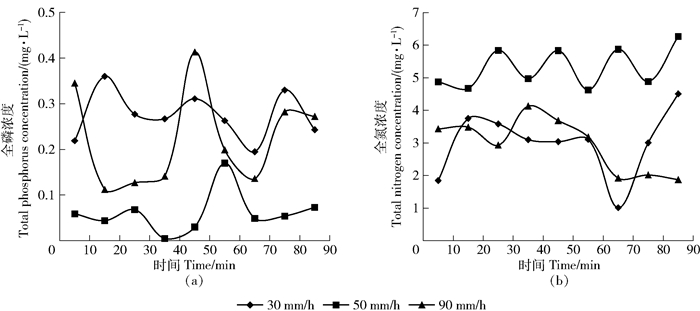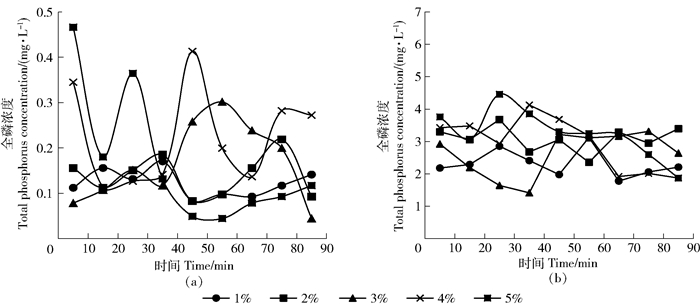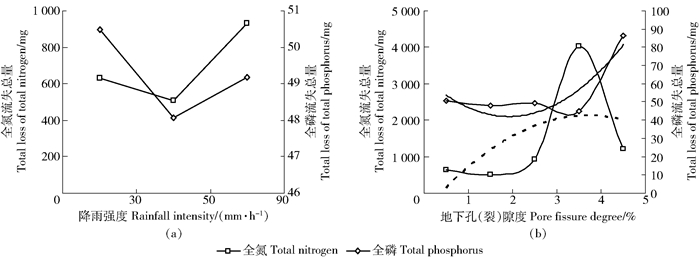2. 贵阳市花溪区黔陶乡人民政府, 550025 贵阳
-
项目名称
- 国家重点研发计划课题"喀斯特高原石漠化综合治理与生物医药产业技术与示范"(2016YFC0502604);国家自然科学基金"喀斯特坡耕地浅层孔(裂)隙水文过程及土壤侵蚀响应机制","喀斯特坡耕地土壤养分地下裂隙度流失特征与机理"(41671275,41461057);贵州省重大专项"草海流域生态保护与治理工程支撑技术集成示范"(黔科合重大专项字[2016]3022号);贵州省应用基础重大专项"喀斯特石漠化区生态容量与可供给植被恢复潜力研究"(黔科合JZ字[2014]2002);贵州省一流学科建设项目(GNYL[2017]007)
-
第一作者简介
- 杨宇琼(1992-), 女, 硕士研究生。主要研究方向:退化生态系统恢复与重建。E-mail:464444281@qq.com
-
通信作者简介
- 戴全厚(1969-), 男, 教授, 博士生导师。主要研究方向:水土保持与生态恢复重建。E-mail:qhdairiver@163.com
-
文章历史
-
收稿日期:2017-07-17
修回日期:2017-11-15
2. 贵阳市花溪区黔陶乡人民政府, 550025 贵阳
2. The People's Government of Qiantao Township, Huaxi District, 550025, Guiyang, China
西南喀斯特地区的石漠化是我国西部大开发中生态环境建设所面临的突出地域环境问题[1],而喀斯特作为一种具有特殊的物质、能量、结构和功能的生态系统[2],其特征是环境容量低,稳定性差,地表渗漏严重,保水性差,极易造成水土流失[3]。贵州喀斯特坡耕地出露面积约11万km2,占全省面积的61.9% [4]。坡耕地严重的水土流失导致的农田表层土壤及氮磷等营养物质的流失,是土壤质量退化的重要原因,而且增加了水体中营养物质的负荷量使水体富营养化[5],而富营养化严重的水体会引起供水障碍以及人畜饮水安全[6];因此研究坡耕地养分流失不仅是一个农业问题,更是一个生态环境问题[7]。喀斯特坡耕地区水土流失过程极其复杂,其地下存在裂隙、溶管、漏斗、竖井、落水洞、溶洞等[8],水文系统是地上、地下双层开放。有研究表明,在典型喀斯特岩溶山地区,地下水入渗率为0.3~0.6,最高可达0.8[9]。目前,国内外关于喀斯特地区地下水土漏失的研究大多偏于定性描述,如王恒松等[10],周念清等[11],张信宝等[12],WANG等[13],ZHOU等[14]。也有少数学者通过室内模拟定量研究了水土地下漏失过程,如DAI等[15]研究了喀斯特石漠化地区裸坡地的径流过程以及地下裂隙度对岩溶土壤侵蚀的影响。彭旭东等[16]研究喀斯特山地石漠化过程中地下侵蚀产沙特征。据刘秉正等[17]的研究结果,土壤养分流失与水土流失紧密相联,而且李昌兰等[18]通过人工模拟降雨和室内分析相结合的方法,认为喀斯特坡耕地地下浅层裂隙养分流失是造成地下水污染的关键,但很少涉及土壤养分地下漏失的定量研究。
笔者拟通过人工模拟降雨试验,控制坡度和基岩裸露率水平,研究降雨强度和地下裂隙度对喀斯特坡耕地氮磷地下漏失的影响,其结果有助于揭示喀斯特坡耕地地下养分漏失机理,为喀斯特地区水土漏失及生态环境污染提供科学依据,因地制宜地制订水土保持工作,达到综合治理的目的。
1 研究区概况供试土壤取自贵州省贵阳市花溪区坡耕地(E 106°39′18″,N 26°19′17″)石灰土0~20 cm耕作层土,其土壤主要有砂粒、粉粒和黏粒。其中全氮质量分数为9.72 g/kg,全磷为2.04 g/kg,全钾为8.72 g/kg。试验用土不过筛,在室内风干后,对大的土壤团块进行分散处理,放置在阴处备用。
2 材料与方法 2.1 试验设计通过查阅喀斯特地域环境特征及野外调查资料,试验设定地下裂隙度为1%、2%、3%、4%、5%,地下裂隙度是通过试验钢槽底板均匀打孔(5 cm)并通过2块钢板圆孔错位控制孔隙大小[19],降雨强度为30、50、90 mm/h。根据野外调查统计,设计典型坡度为15°。试验前要先填装钢槽[20],根据试验设计基岩裸露率水平10%,将已测量标记出35 cm以上部分露头面积的碳酸盐岩石随机排列在试验钢槽中,按自下而上土壤紧实度平均值1 070、760、290 kPa分3层回填土,然后在贵州大学南校区苗圃大厅进行人工模拟降雨试验,每次降雨历时90 min。
2.2 样品采集与分析当产流开始时,每间隔10 min取1次径流样,分槽收集径流,测量径流体积,并记录,同时用相同规格塑料瓶分取径流水样。取样后统一现场加酸保存,并于24 h内按历次降雨分批次测定全氮全磷的含量。具体操作步骤参考文献[21]。试验数据用Excel和SPSS软件进行处理。
3 结果与分析 3.1 降雨强度和地下裂隙度对地下产流过程的影响由分析不同降雨强度和地下裂隙度条件下地下径流量各个时间段的变化情况(图 1)可见:当地下裂隙度为1%和2%时,地下径流量在产流前20 min先迅速增加后缓慢增加到30 min趋于稳定,此时土壤水分达到饱和状态;当地下裂隙度为3%和4%时,地下径流量的变化规律同1%和2%,60 min时径流量趋于稳定,此时土壤水分处于过饱和状态;当地下裂隙度5%时,地下径流量在产流前10 min达到最大值,产流20 min时处于过饱和状态,后逐渐下降至80min时趋于稳定。总体上说地下产流量随地下裂隙度增加而增加,表明地下裂隙度发育较好时更容易导致地下土壤流失。其原因是:该试验对象为裸坡地,无植被截留,在产流初期,土壤下渗率较大,因此地下径流量迅速增加,而且随着地下裂隙度的增大,土壤在产流初期的下渗率也越大;但随着产流时间延长,土壤团粒被雨滴破环、分散,并随水分下渗到土壤孔(裂)隙中,堵塞土壤的毛管孔隙,使土壤下渗率减小。因此地下径流量增加缓慢,甚至减少,当土壤饱和后,地下径流量便不会出现太大变化。当地下裂隙度一定的情况下,不同降雨强度地下产流表现为:50>90>30 mm/h。表 1示出不同降雨强度和地下裂隙度下地下产流特征:当降雨强度不变时,产流总量随地下裂隙度的增大而增大,相关系数R为0.766;当地下裂隙度一定时,地下产流总量跟降雨强度呈正相关,相关系数R为0.573。

|
图 1 不同降雨强度和地下裂隙度条件下地下产流随降雨历时变化过程 Figure 1 Variation of underground runoff under different rainfall intensity and underground pore fissure degree |
| 表 1 不同降雨强度和地下裂隙度下地下产流特征 Table 1 Characteristics of underground runoff under different rainfall intensity and underground pore fissure degree |
降雨过程中,坡面土壤侵蚀不仅仅是泥沙随径流发生剥离,搬运,沉积。在此过程中,土壤养分亦在径流作用下发生流失,由此可见降雨是导致水土及养分流失的主要因素之一[22]。图 2反映不同降雨强度条件下径流全氮、全磷浓度的变化。由图 2(a)可以看出,全磷浓度随降雨强度呈现出波状变化,降雨强度为小降雨强度(30 mm/h)和中降雨强度(50 mm/h)时的全磷浓度变化幅度不如极端暴雨(90 mm/h)的明显,大降雨强度全磷浓度峰值明显高于小降雨强度全磷浓度峰值。降雨强度为30 mm/h时,全磷浓度变化范围为0.195~0.36 mg/L,降雨强度为50 mm/h时,全磷浓度变化范围为0.005~0.17 mg/L,极端暴雨(90 mm/h)情况下,全磷浓度变化范围为0.112~0.413 mg/L,总体变化规律不是很明显,分析其原因是磷元素容易被土壤固定。图 2(b)反映的是全氮浓度随降雨强度的变化,30,50,90 mm/h的全氮浓度变化范围分别为1.011~4.505 mg/L,4.626~6.262 mg/L和1.873~4.128 mg/L,全氮流失浓度总体上随降雨强度呈增大趋势。

|
坡度为15°,地下裂隙度4%。 The slope is 15 degree and the degree of underground fissure is 4%. 图 2 不同降雨强度条件下地下径流全磷、全氮浓度变化特征 Figure 2 Characteristics of total P and N concentration in underground runoff under different rainfall intensity |
地下浅层孔(裂)隙是喀斯特地区水土及养分流失的重要途径,它对地下产流有显著的影响。图 3表示90 mm/h全氮全磷浓度随地下裂隙度的变化情况。图 3(a)中全磷浓度与地下裂隙度呈波浪式变化:当地下裂隙度为3%时,全磷浓度在降雨历时60 min达到最大值为0.301 mg/L;在4%地下裂隙度发育条件下,全磷浓度在降雨历时50 min达到峰值,此时的全磷浓度为0.413 mg/L;在5%地下裂隙度的发育条件下,全磷浓度在降雨30 min达到峰值0.364 mg/L;地下裂隙度为1%和2%时,全磷浓度分别在降雨历时40和80 min达到最大值0.185和0.219 mg/L。其原因是,全磷的流失是一个复杂的过程,它有很多影响因子,地下裂隙度只对全磷浓度峰值大小产生影响,对整个全磷浓度的流失无明显影响[23];图 3(b)中全氮的浓度在地下裂隙度为5%时达到最大值4.485 mg/L,当地下裂隙度为1%时,全氮浓度为2.930 mg/L,5%的地下全氮浓度是1%的1.53倍,对全氮浓度与地下裂隙度进行相关性分析。结果显示二者呈现显著正相关,相关系数为0.906。

|
图 3 不同地下裂隙度条件下地下径流全磷、全氮浓度变化特征 Figure 3 Characteristics of total P and N concentration in underground runoff under different underground pore fissure degree |
表 2、表 3是不同降雨强度和地下裂隙度下喀斯特坡耕地地下径流中全氮、全磷流失量及流失量的拟合方程。由表可以看出:当降雨强度为30 mm/h时,径流中全氮流失总量随地下裂隙度的增大总体呈增加趋势,全磷流失量则变化不明显;当降雨强度为50 mm/h时,全氮流失量变化趋势同30 mm/h降雨强度,全磷流失量则除了孔隙度为2%和3%时异常增多,其余保持不变;当降雨强度为90 mm/h时,全氮流失量的增加趋势不如小降雨强度时明显,全磷变化趋势则同50 mm/h降雨强度。当地下裂隙度一定时,随着降雨强度的增大,径流中全氮流失量也均呈增加趋势,全磷的增加趋势很不明显。随着降雨强度的增大,不同地下裂隙度下径流全氮流失量的极差呈先增加后减小的循环趋势,说明不同孔隙度对全氮流失的差别不同,全磷流失量的极差在2%和3%孔隙度时明显增大。在相同的孔隙度下,全氮流失量的极差总是大于全磷流失量的极差,这说明降雨强度对全氮流失的影响作用强于对全磷的影响,总体上说全磷的流失量显著低于全氮的流失量,分析其原因是硝氮不易被土壤胶体所固定,大部分的氮素是以溶解态的硝氮形式流失[24]。
| 表 2 不同降雨强度和地下裂隙度下氮磷流失量 Table 2 Loss of total N and P under different rainfall intensity and underground pore fissure degree |
| 表 3 不同降雨强度和地下裂隙度下氮磷流失量的拟合方程 Table 3 Fitting equation of nitrogen and phosphorus loss under different rainfall intensity and underground pore fissure degree conditions |
根据室内人工降雨数据,表 4对累积径流量与氮磷累积流失量进行了相关性分析,可以看出累积径流量与径流中全氮全磷的累积流失量有显著关系。全氮累积流失量与累积径流量的拟合方程为y=0.165 5x+2.147 9,相关系数为0.986 3,全磷累积流失量与累积径流量的拟合方程为y=4.409 2x-53.793,相关系数为0.997 4。这表明径流中全氮全磷的流失量不仅受降雨强度、孔隙度的影响,还受径流累积流失量的影响;因此可以根据降雨量与径流系数估算出径流量,推导出氮素的输出量,从而为面源污染的控制提供了新的思路。
| 表 4 累积径流量与氮磷累积流失量的拟合方程 Table 4 Fitting equation of cumulative runoff and nitrogen and phosphorus loss |
由图 4(a)可知:当地下裂隙度一定时,全氮及全磷的流失总量与降雨强度均呈现出线性关系,全氮流失总量与降雨强度变化的关系式为y=5.785x+360.46,相关系数为0.658 1;全磷流失总量与降雨强度变化拟合方程为y=-0.014 6x+50.064,相关系数为0.136 3;图 4(b)中分别为全氮、全磷流失总量在不同地下裂隙度条件下的变化过程,不同地下裂隙度条件下,全氮流失总量与地下裂隙度的拟合方程式为y=169.89x+352.6,相关系数为0.848 9;全磷流失总量与地下裂隙度的拟合方程式为y=5.884 4x2-28.438x+76.39,相关系数为0.806 8。由此可见,地下裂隙度对地下径流中养分的流失不是简单的线性关系,而且地下径流中全氮的流失量高于全磷,分析其原因是试验土壤本身含氮很高[19]。

|
图 4 降雨强度和地下裂隙度对全氮全磷流失总量的影响 Figure 4 Effects of rainfall intensity and underground pore fissure degree on total N and P loss |
1) 土壤养分流失一部分随径流流失,一部分随泥沙迁移流出地表,而降雨特征直接影响坡耕特征,从而对土壤养分流失有不同程度的影响。降雨强度为整个水-土体系提供了动力和能量[25]。笔者发现:地下产流总量随降雨强度的增大而增大,而地下径流中养分漏失浓度均随降雨强度呈坡状变化,其中全氮漏失浓度与降雨强度呈正相关关系,这与黄满湘等[26]的研究结果一致,即农田氮素流失量随雨强的增大逐渐增加;地下径流中的全磷浓度随雨强变化规律不明显,这与罗春燕等[27]采用野外径流小区试验观测雨强对坡耕地养分流失影响的结果一致,这可能是因为磷素容易被土壤固定,再加之土壤入渗及磷素在土壤中的运移需要一定时间,因此磷素浓度只有在经过一段时间后出现了最大值[18],之后随着降雨历时增加而逐渐降低并趋于稳定。笔者还发现累积径流量与地下径流中全氮全磷的累积流失量有显著关系,这与张亚丽等[28]等人的研究结果相似。
2) 喀斯特环境条件下浅层地下裂隙度的发育是地下水土及养分漏失的关键因素,同时也是加剧石漠化发展和地下水污染的重要因子。相关研究表明,喀斯特区碳酸盐岩岩石节理发育及溶蚀作用形成的地下裂隙、岩溶管道、落水洞等[29],为喀斯特区水土及其养分流失提供了运移通道。同时,在喀斯特生态系统中,发达的植物根系不仅可吸收土层中的水分和养分,还可以伸入岩石裂隙中,吸收利用其水分及养分。笔者发现:全氮流失量随地下裂隙度呈增加趋势,且全氮浓度在地下裂隙度为5%时,到达最大值,说明此时的地下径流全氮最容易流失,因此加强对地下孔(裂)隙形成机理研究对防治氮素流失具有重要作用;地下径流全磷浓度与地下裂隙度呈波状变化,在5%地下裂隙度发育条件下,地下径流全磷浓度在降雨历时50 min达到峰值,说明地下裂隙度对整个磷素的流失浓度影响不明显,但可以影响其峰值出现的大小,这与陈玲等[30]的试验研究结论基本一致。同时,地下径流是喀斯特坡耕地主要的养分流失方式,地下产流量随地下裂隙度增加而增加,这与陈洪松等[31]、陈磊等[32]对喀斯特野外径流小区定位观测结果一致;因此,控制地下径流的形成是减少该区土壤养分流失的关键。然而,笔者采用室内钢槽底板圆孔来模拟喀斯特坡耕地地下裂隙与野外实际裂隙发育情况还存在差异,野外裂隙构造极其复杂;因此,在以后的养分漏失研究中,针对复杂多变的喀斯特岩-土裂隙环境,应多开展室内模拟结合野外定位观测的校验研究。
5 结论1) 当降雨强度一定时,地下产流量随地下裂隙度增加而增加,二者相关系数为0.766;当地下裂隙度一定时,不同降雨强度地下产流表现为:50 mm/h>90 mm/h>30 mm/h,地下产流总量跟降雨强度呈正相关,相关系数为0.573。
2) 全磷浓度随降雨强度呈现出波状变化,小降雨强度的全磷浓度变化幅度不如大降雨强度的明显,而且大降雨强度全磷浓度峰值明显高于小降雨强度全磷浓度峰值。全氮流失浓度总体上随降雨强度呈增大趋势。
3) 全磷浓度与地下裂隙度呈波浪式变化;全氮浓度与地下裂隙度呈显著性正相关,相关系数为0.906。
4) 累积径流量与径流中全氮全磷的累积流失量有显著关系,相关系数分别为0.986 3和0.997 4。全氮全磷流失总量与降雨强度可用线性拟合,全氮全磷流失总量与地下裂隙度可用多项式拟合。
| [1] |
黄秋昊, 蔡运龙, 王秀春. 我国西南部喀斯特地区石漠化研究进展[J].
自然灾害学报, 2007, 16(2): 106.
HUANG Qiuhao, CAI Yunlong, WANG Xiuchun. Progress of research on rocky desertification in karst areas of southwestern China[J]. Journal of Natural Disasters, 2007, 16(2): 106. |
| [2] |
袁道先.
中国岩溶学[M]. 北京: 地质出版社, 1993: 133.
YUAN Daoxian. Karstification in China[M]. Beijing: Geological Publishing House, 1993: 133. |
| [3] |
张殿发, 王世杰, 李瑞玲. 贵州省喀斯特山区生态环境脆弱性研究[J].
地理与地理信息科学, 2002, 18(1): 77.
ZHANG Dianfa, WANG Shijie, LI Ruiling. Study on the eco-environmental vulnerability in Guizhou Karst Mountains[J]. Geography and Territorial research, 2002, 18(1): 77. |
| [4] |
李宗发. 贵州喀斯特地貌分区[J].
贵州地质, 2011, 28(3): 1771.
LI Zongfa. Division of Karst landform in Guizhou[J]. Guizhou Geology, 2011, 28(3): 1771. |
| [5] |
邱光胜, 胡圣, 叶丹, 等. 三峡库区支流富营养化及水华现状研究[J].
长江流域资源与环境, 2011, 20(3): 311.
QIU Guangsheng, HU Sheng, YE Dan, et al. Investigation on the present situation of eutrophication and water bloom in the branches of three gorges reservoir[J]. Resources and Environment in the Yangtze Basin, 2011, 20(3): 311. |
| [6] |
马经安, 李红清. 浅谈国内外江河湖库水体富营养化状况[J].
长江流域资源与环境, 2002, 11(6): 576.
MA Jingan, LI Hongqing. Preliminary discussion on eutrophication status of lakes, reservoirs and rivers in China and overseas[J]. Resources and Environment in the Yangtze Basin, 2002, 11(6): 576. |
| [7] |
王帅兵, 刘华, 朱朝辉, 等. 坡地养分流失研究现状及控制技术[J].
绿色科技, 2012(6): 143.
|
| [8] |
刘丛强, 蒋颖魁, 陶发祥, 等. 西南喀斯特流域碳酸盐岩的硫酸侵蚀与碳循环[J].
地球化学, 2008, 37(4): 404.
LIU Congqiang, JIANG Yingkui, TAO Faxiang, et al. Chemical weathering of carbonate rocks by sulfuric acid and the carbon cycling in Southwest China[J]. GEOCHIMICA, 2008, 37(4): 404. |
| [9] |
杨智, 戴全厚, 黄启鸿, 等. 典型喀斯特坡面产流过程试验研究[J].
水土保持学报, 2010, 24(4): 81.
YANG Zhi, DAI Quanhou, HUANG Qihong, et al. Experimental study of runoff processes on typical Karst slope[J]. Journal of Soil and Water Conservation, 2010, 24(4): 81. |
| [10] |
王恒松, 熊康宁, 刘云. 喀斯特区地下水土流失机理研究[J].
中国水土保持, 2009(8): 11.
WANG Hengsong, XIONG Kangning, LIU Yun. Mechanism research of soil and water loss underground in Karst region[J]. Journal of Soil and Water Conservation, 2009(8): 11. |
| [11] |
周念清, 李彩霞, 江思珉, 等. 普定岩溶区水土流失与土壤漏失模式研究[J].
水土保持通报, 2009, 29(1): 7.
ZHOU Nianqing, LI Caixia, JIANG Simin, et al. Models of soil and water loss and soil leakage in Puding Karst area[J]. Bulletin of Soil and Water Conservation, 2009, 29(1): 7. |
| [12] |
张信宝, 王世杰, 曹建华. 西南喀斯特山地的土壤硅酸盐矿物物质平衡与土壤流失[J].
地球与环境, 2009, 37(2): 97.
ZHANG Xinbao, WANG Shijie, CAO Jianhua. Mass balance of silicate minerals in soils and soil losses in the Karst mountainous regions of southwest China[J]. Earth and Environment, 2009, 37(2): 97. |
| [13] |
WANG J X, ZOU B P, LIU Y, et al. Erosion-creep-collapse mechanism of underground soil loss for the karst rocky desertification in Chenqi village, Puding County, Guizhou, China[J].
Environmental Earth Sciences, 2014, 72(8): 2751.
DOI: 10.1007/s12665-014-3182-0. |
| [14] |
ZHOU J, TANG Y, YANG P, et al. Inference of creep mechanism in underground soil loss of karst conduits Ⅰ. Conceptual model[J].
Natural Hazards, 2012, 62(3): 1191.
DOI: 10.1007/s11069-012-0143-3. |
| [15] |
DAI Quanhou, PENG Xudong, ZHAO Longshan, et al. Effects of underground pore fissures on soil erosion and sediment yield on karst slopes[J].
Land Degradation & Development, 2017, 28(7): 1922.
|
| [16] |
彭旭东, 戴全厚, 杨智, 等. 喀斯特山地石漠化过程中地表地下侵蚀产沙特征[J].
土壤学报, 2016, 53(5): 1237.
PENG Xudong, DAI Quanhou, YANG Zhi, et al. Sediment yield of surface and underground erosion in the process of rocky desertification of Karst area[J]. Journal of Soil, 2016, 53(5): 1237. |
| [17] |
刘秉正, 李光录, 吴发启, 等. 黄土高原南部土壤养分流失规律[J].
水土保持学报, 1995, 9(2): 95.
LIU Bingzheng, LI Guanglu, WU Faqi, et al. The regular patterns of the loss of soil nutrients on the southern Loess Plateau[J]. Journal of Soil and Water Conservation, 1995, 9(2): 95. |
| [18] |
李昌兰, 戴全厚, 彭旭东, 等. 喀斯特坡耕地浅层地下孔(裂)隙发育过程中径流产污特征[J].
环境科学学报, 2016, 36(12): 4437.
LI Changlan, DAI Quanhou, PENG Xudong, et al. Characteristics of nitrogen, phosphorus and potassium losses in underground runoff of Karst slope farmlands during the developing process of shallow Karst fissure[J]. Acta Scientiae Circumstantiae, 2016, 36(12): 4437. |
| [19] |
彭旭东, 戴全厚, 李昌兰, 等. 模拟雨强和地下裂隙对喀斯特地区坡耕地养分流失的影响[J].
农业工程学报, 2017, 33(2): 133.
PENG Xudong, DAI Quanhou, LI Changlan, et al. Effect of simulated rainfall intensities and underground pore fissure degrees on soil nutrient loss from slope farmlands in Karst Region[J]. Transactions of the Chinese Society of Agricultural Engineering, 2017, 33(2): 133. |
| [20] |
戴全厚, 喻理飞, 杨智, 等. 一种用于研究坡面径流和地下孔裂隙流的模拟试验装置: 201210391855. 2[P]. 2013-01-02.
DAI Quanhou, YU Lifei, YANG Zhi, et al. A simulation test device for the study of slope runoff and fracture flow in the underground hole: 201210391855. 2[P]. 2013-01-02. |
| [21] |
鲁如坤.
土壤农业化学分析方法[M]. 北京: 中国农业科技出版社, 1999: 125.
LU Rukun. Soil agrochemical analysis method[M]. Beijing: China Agricultural Science and Technology Press, 1999: 125. |
| [22] |
贾洪文. 降雨与土壤养分流失关系分析[J].
水土保持应用技术, 2007(1): 23.
JIA Hongwen. Analysis of relationship between rainfall and soil nutrient loss[J]. Technology of Soil and Water Conversation, 2007(1): 23. |
| [23] |
邬伦, 李佩武. 降雨-产流过程与氮、磷流失特征研究[J].
环境科学学报, 1996, 16(1): 116.
WU Lun, LI Peiwu. Studies on rainfall process, flow-making and nitrogen and phosphorus losses[J]. Acta Scientiae Circumstantiae, 1996, 16(1): 116. |
| [24] |
潘瑞炽, 童愚得.
植物生理学[M]. 北京: 高等教育出版社, 1984: 35.
PAN Ruichi, TONG Yude. Plant physiology[M]. Beijing: Higher Education Press, 1984: 35. |
| [25] |
穆天亮, 王全九, 王辉. 黄土坡面定雨强入渗产流物理基础模型研究[J].
西北农林科技大学学报(自然科学版), 2009, 37(10): 199.
MU Tianliang, WANG Quanjiu, WANG Hui. Study on physical base model of infiltration and runoff formation on loess slope land for a fixed rainfall intensity during rainfall[J]. Journal of Northwest A&F University (Nat. Sci. Ed.), 2009, 37(10): 199. |
| [26] |
黄满湘, 章申, 张国梁, 等. 北京地区农田氮素养分随地表径流流失机理[J].
地理学报, 2003, 58(1): 147.
HUANG Manxiang, ZHANG Shen, ZHANG Guoliang, et al. Losses of nitrogen nutrient in overland flow from farmland in Beijing under simulated rainfall conditions[J]. Acta Geographica Sinica, 2003, 58(1): 147. DOI: 10.11821/xb200301018. |
| [27] |
罗春燕, 涂仕华, 庞良玉, 等. 降雨强度对紫色土坡耕地养分流失的影响[J].
水土保持学报, 2009, 23(4): 24.
LUO Chunyan, TU Shihua, PANG Liangyu, et al. Effect of rain intensity on nutrient losses from sloping land of purple soil[J]. Journal of Soil and Water Conservation, 2009, 23(4): 24. |
| [28] |
张亚丽, 张兴昌, 邵明安, 等. 降雨强度对黄土坡面矿质氮素流失的影响[J].
农业工程学报, 2004, 20(3): 55.
ZHANG Yali, ZHANG Xingchang, SHAO Mingan, et al. Impact of rainfall intensity on soil mineral nitrogen loss by runoff on loess slope[J]. Transactions of the Chinese Society of Agricultural Engineering, 2004, 20(3): 55. |
| [29] |
高建平, 吴桂武, 黄震, 等. 浅析黔东地区岩溶地下水水化学特征[J].
地下水, 2015, 37(6): 22.
GAO Jianping, WU Guiwu, HUANG Zhen, et al. Hydro chemical characteristics' of Karst groundwater in eastern Guizhou[J]. Underground water, 2015, 37(6): 22. |
| [30] |
陈玲, 刘德富, 宋林旭, 等. 不同雨强下黄棕壤坡耕地径流养分输出机制研究[J].
环境科学, 2013, 34(6): 2152.
CHEN Ling, LIU Defu, SONG Linxu, et al. Characteristics of nutrient loss by runoff in sloping arable land of yellow-brown under different rainfall intensities[J]. Environmental Science, 2013, 34(6): 2152. |
| [31] |
陈洪松, 邵明安, 张兴昌, 等. 野外模拟降雨条件下坡面降雨入渗、产流试验研究[J].
水土保持学报, 2015, 19(2): 5.
CHEN Hongsong, SHAO Mingan, ZHANG Xingchang, et al. Field experiment on hillslope rainfall infiltration and runoff under simulated rainfall conditions[J]. Journal of Soil and Water Conservation, 2015, 19(2): 5. |
| [32] |
陈磊, 李占斌, 李鹏, 等. 野外模拟降雨条件下水土流失与养分流失耦合研究[J].
应用基础与工程科学学报, 2011(S1): 171.
CHEN Lei, LI Zhanbin, LI Peng, et al. The coupling effect on soil erosion and nutrient lost under simulated rainfall[J]. Journal of Basic Science and Engineering, 2011(S1): 171. |
 2018, Vol. 16
2018, Vol. 16 
